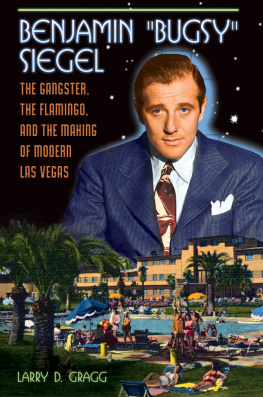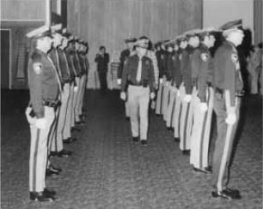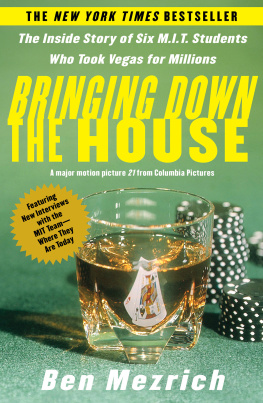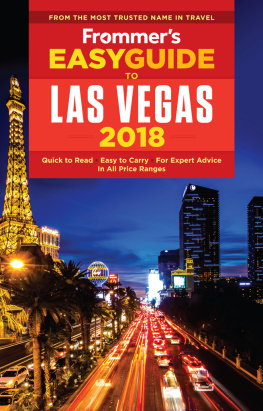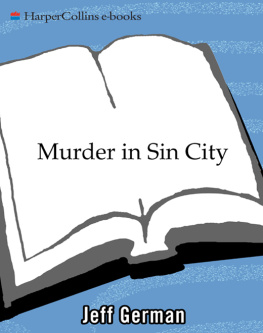Allrights reserved.
Introduction
Oh, What a Tangled Web We Weave.
Most people have a romanticized image of the Mob andLas Vegas floating around in their head. They think of the movie TheGodfather and imagine the Mob came to Las Vegas, a few people were shot,and then the FBI came along andstraightened everything out. Nothing could be further from the truth! Inaddition to great staying power, the Mob was very concerned about their imagein Nevada and went to great lengths to make sure that when they had to whack somebody,it was done out of town, but it was still done, regularly.
If you want to think of a movie to personify the Mobspre-Las Vegas activity, think of The Departed. Thats right, rememberwhen Leonardo DeCaprio was bent over a pool table having his already-broken armbeaten with a heavy boot? Thats more like the way it was. T here were no nice guys and every day was life anddeath. Tough guys beat, tortured, and killed their competitors, and sometimesmoved up in the family hierarchy. When they did, the heads of other familiestried to kill them. Often they were successful. And then along came Las Vegas,a place in the sun.
The Mob had a strong grip on Las Vegas by the time theKefauver Committee came along in 1951 and spilled the beans that mobstersowned casinos in Nevada. Sure, there had been suspicion, but TV viewers werestill shocked by what they heard and saw. They would have been even moreshocked to learn that the FBI already knew what was being discussed on TV becausethey had been tapping phones in Vegas for almost ten years, but they nevershared their information. So, with all the new-found knowledge, did anythingchange? Not really.
The Mob ruled the casinos and the politicians, and thepublic went warily along with their gambling, hoping they were safe. They knewthat Bugsy Siegel once said, We only kill our own, so they watchedover their shoulder and hoped for the best. It was exciting. Siegel , as you may have heard, made a name for himself longbefore he came to Nevada, and it wasnt for selling bubble gum.
During Prohibition in the 1920s, every person with abathtub could make gin, and every person with a whistle to wet could get adrink at a local speakeasy. It was a sign of the times, like flappers,prosperity, and the Ford Model T automobile, because nine out of every ten carssold were Fords. By the same token, nine out of every ten illegal casinos werepaying juice to the local gang, and the Sheriff, and the councilmen, and themayor, and sometimes there wasnt much left for the operator, but thensomething wonderful happened, Nevada legalized gaming.
Although gambling was as easy to find as bootlegwhiskey in Nevada, games of chance had to be housed out of view of passerbyon the streets. Casinos flourished in basements and second story lofts, but in1930, a 29-year old Republican State Assemblyman named Phil Tobin used a failed 1929 bill for the legalization ofgambling and presented it to his fellow politicians. This time they wereinterested. The Great Depression was crushing Nevadas few legal businesses,and the state was about to collapse within its borders.
Passage seemed more certain this time, but just tomake sure everything went right for the sporting men, as the illegal casinoowners liked to call themselves, Reno s George Wingfield and Bill Cinch Graham rained money down on the politicians like confetti.The bill passed the Nevada State Assembly and the Senate easily, and GovernorFred Balzar signed the bill into law onMarch 19, 1931. Casinos were legally taking players money before the ink coulddry.
The Northern Club in Las Vegas got its gaming permitthe next day from the Sheriffs Department. Owners Morgan and Stockercelebrated their legal status with free drinks at the bar until the regularevening crowd came in, then it was business, and drink prices, as usual. Youcould still get a good cigar for a nickel, or soda pop. Whiskey at the bar wasa dime. The six slot machines in the corner were nickel and dime varieties. Thecasino offered a tub-style crap game and a roulette wheel. If you wanted toplay poker, there were tables near the bar, where the air was continuallyfilled with a haze of blue smoke that the belt-driven fans could do little todisperse. The skim of Las Vegas casino profits was soon to come.
The Boulder Club and Las Vegas Club were licensed a week later. Bugsy Siegel would someday have an office in the Las Vegas Clubwhere the FBI secretly listened to everyphone call but did nothing to stop the flow of Vegas cash to Meyer Lansky and his Mob associates. What a great country!
Away from the confines of downtown, the Meadows in Meadow Acres and the Pair-O-Dice out on Highway 91 were licensed during the summer. TheMeadows was run by Los Angeles bootlegger Tony The Hat Cornero and his brother, who had supplied, and been made rich,by several Mob families. The new club was described by the Las Vegas Agenewspaper as, "Potent in its charm, mysterious in its fascination, theMeadows, America's most luxurious casino, will open its door's tonight andformally embark upon a career which all liberal minded persons in the West willwatch closely."
Apparently, not-so-liberal minded people on the east coastwere also watching closely. Lucky Luciano (November 24, 1897, Lercara Friddi,Sicily, Italy) helped bankroll Cornero s bootlegging operations and wanted a piece of thepie. He sent Meyer Lansky to investigate, who found the resort to be quitedelightful, with carpeting, polished tile, and a tight little casino withroulette tables, craps, faro, chuck-a-luck, and slot machines. The players wererubes, lacking in gaming skill. The money was good.
Lansky relayed the news that Luciano expected 25 percent off the top. Cornero refused and sent Meyer on his way. He didnt get mad;he got even. The next week a fire burned down the casino. Cornero and hisbrother burned a hole in the highway back to California and stayed away for 15years.

1 Prohibition riches
The casinos of Nevada were watched closely by gangs inDetroit, Kansas City, Minneapolis, and Toledo. In New York, Charles Luciano had his own casinos but told associate Meyer Lansky to compare the casinos in Nevada to his operations inthe Big Apple and those in Kentucky. In Chicago , Al Capone was already familiar with Bill Grahams clubs in Reno and knew Graham was available for moneylaundering through his casinos and George Wingfield s Riverside Bank. The Reno group had already handledhundreds of thousands in bogus stock deals and was willing to help Alvin Karpis and Ma Barkers gang when they needed to launder ransom money fromtheir kidnappings.
When they did, the gang members would hang around theRex and Bank Clubs , drinking slowly, and sometimes losing most of whatthey came to launder after Graham took his 15 percent fee. A year later,Pretty Boy Floyd was in town, followed quickly by Baby Face Nelson , whom Graham set up with a home just a few blocksfrom his own. Reno was cozy.
Capone didnt care much about the Reno clubs in the 1930s because his casinos in Chicago produced more income than any clubs in Nevada did,and besides, he was the King of Bootlegging, so he didnt watch too closely. Heshould have been watching the government, and Elliot Ness, who had a seriousinfatuation with capturing Capone doing something illegal that he could charge himwith. There were some informants and witnesses, but they kept having accidentsand disappearing. None ever testified in court. Eventually, Ness and a team ofaccountants managed to get Capone convicted of tax evasion in 1931.


